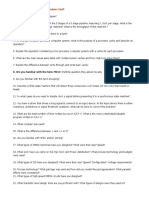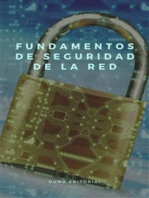0 ratings0% found this document useful (0 votes)
33 viewsInterview Questions-Deepak
Interview Questions-Deepak
Uploaded by
Deepak TiwariThe document discusses various concepts related to testing digital circuits including scan insertion. It asks about clock skew, synchronous vs asynchronous reset, scan specifications, non-scan flops coverage, hold time violations, scan synthesis, lock-up latches usage scenarios, wrapper flops insertion, dedicated and shared wrapper cells, LOC vs LOS, testability, scan insertion tools and commands, design rule check violations, scan insertion outputs, compression techniques, EDT update signals, JTAG architecture and pins, IDCODE register, INTEST and EXTEST operations, and OCC architecture.
Copyright:
© All Rights Reserved
Available Formats
Download as DOCX, PDF, TXT or read online from Scribd
Interview Questions-Deepak
Interview Questions-Deepak
Uploaded by
Deepak Tiwari0 ratings0% found this document useful (0 votes)
33 views1 pageThe document discusses various concepts related to testing digital circuits including scan insertion. It asks about clock skew, synchronous vs asynchronous reset, scan specifications, non-scan flops coverage, hold time violations, scan synthesis, lock-up latches usage scenarios, wrapper flops insertion, dedicated and shared wrapper cells, LOC vs LOS, testability, scan insertion tools and commands, design rule check violations, scan insertion outputs, compression techniques, EDT update signals, JTAG architecture and pins, IDCODE register, INTEST and EXTEST operations, and OCC architecture.
Original Title
Interview questions-Deepak
Copyright
© © All Rights Reserved
Available Formats
DOCX, PDF, TXT or read online from Scribd
Share this document
Did you find this document useful?
Is this content inappropriate?
The document discusses various concepts related to testing digital circuits including scan insertion. It asks about clock skew, synchronous vs asynchronous reset, scan specifications, non-scan flops coverage, hold time violations, scan synthesis, lock-up latches usage scenarios, wrapper flops insertion, dedicated and shared wrapper cells, LOC vs LOS, testability, scan insertion tools and commands, design rule check violations, scan insertion outputs, compression techniques, EDT update signals, JTAG architecture and pins, IDCODE register, INTEST and EXTEST operations, and OCC architecture.
Copyright:
© All Rights Reserved
Available Formats
Download as DOCX, PDF, TXT or read online from Scribd
Download as docx, pdf, or txt
0 ratings0% found this document useful (0 votes)
33 views1 pageInterview Questions-Deepak
Interview Questions-Deepak
Uploaded by
Deepak TiwariThe document discusses various concepts related to testing digital circuits including scan insertion. It asks about clock skew, synchronous vs asynchronous reset, scan specifications, non-scan flops coverage, hold time violations, scan synthesis, lock-up latches usage scenarios, wrapper flops insertion, dedicated and shared wrapper cells, LOC vs LOS, testability, scan insertion tools and commands, design rule check violations, scan insertion outputs, compression techniques, EDT update signals, JTAG architecture and pins, IDCODE register, INTEST and EXTEST operations, and OCC architecture.
Copyright:
© All Rights Reserved
Available Formats
Download as DOCX, PDF, TXT or read online from Scribd
Download as docx, pdf, or txt
You are on page 1of 1
1.
Explain the concept of clock skew
2. What is difference between synchronous and asynchronous reset?
3. What are the scan specification required before scan insertion?
4. If there are two non-scan flops between two scan flip-flops and after specifying the sequential
depth, will the non-scan flip flops be included in the coverage?
5. Explain hold time violation?
6. What is scan synthesis?
7. Explain the different scenario where we can use lock-up latches?
8. Why to insert wrapper flops?
9. What is dedicated and shared wrapper cell?
10. What is difference between LOC and LOS ?
11. How will you make your design testable?
12. What is scan insertion? Which tool you have used for scan insertion? Explain the command with
switches you have used during scan insertion?
13. What is design Rule check? What are the violations you have faced during Scan insertion?
14. What are the outputs of scan insertion? Explain ?
15. What is Compression? Which technique you have used? Explain the architecture?
16. Why EDT update signal required?
17. What is JTAG? Explain its Architecture? Why RST a optional pin?
18. What is IDCODE Reg?
19. Explain INTEST and EXTEST operation in JTAG?
20. What is OCC? Explain the Architecture?
You might also like
- Q-A's On Atpg & ScanDocument33 pagesQ-A's On Atpg & ScanShankhadeep Das100% (2)
- Interview Questions Related To Scan, ATPG, EDT and SimulationDocument1 pageInterview Questions Related To Scan, ATPG, EDT and SimulationSiva Sreeramdas100% (1)
- DFT Interview QuestionsDocument2 pagesDFT Interview Questionsrupesh kumar100% (1)
- STA InterviewDocument1 pageSTA Interviewpalagani muralibabu100% (1)
- DFT Interview Questions - Welcome To World of VLSIDocument5 pagesDFT Interview Questions - Welcome To World of VLSINaganithesh GhattamaneniNo ratings yet
- 2019 21 InterviewsDocument17 pages2019 21 InterviewsNarala jahnaviNo ratings yet
- ExamDocument2 pagesExamSiva SreeramdasNo ratings yet
- DFT Interview QuestionsDocument2 pagesDFT Interview Questionsrupesh kumar100% (2)
- CS1252 Operating SystemsDocument6 pagesCS1252 Operating SystemsNagarajan m SNo ratings yet
- DFT Imp Questions 250+Document5 pagesDFT Imp Questions 250+Mayur Mestry100% (2)
- Segregated QuestionsDocument1 pageSegregated QuestionsdeepaNo ratings yet
- DFT FaqDocument15 pagesDFT FaqBrijesh S D100% (1)
- DFT Basics & Scan Test PaperDocument1 pageDFT Basics & Scan Test PapergangadharisireeshaNo ratings yet
- DFT - Interview Qns - 02 - 8Document38 pagesDFT - Interview Qns - 02 - 8shashindra KGNo ratings yet
- Interview QuestionsDocument3 pagesInterview Questionsmahesh bagariNo ratings yet
- DFT QnsDocument6 pagesDFT QnsRajisha100% (1)
- DFT Interview QuestionsDocument3 pagesDFT Interview QuestionsJayesh PopatNo ratings yet
- DFT Interview Question2Document1 pageDFT Interview Question2pravallika vysyarajuNo ratings yet
- Broadcom Interview QuesDocument5 pagesBroadcom Interview QuesShaki Bhanu100% (1)
- DFT Interview QuestionsDocument2 pagesDFT Interview Questionsjagruthims75% (4)
- Skandysys Interview QuestionDocument2 pagesSkandysys Interview QuestionMayur MestryNo ratings yet
- Scan Insertion Assignment - 1Document17 pagesScan Insertion Assignment - 1poojithas acharya100% (5)
- Cyient Interview QestionDocument1 pageCyient Interview QestionkhaleelNo ratings yet
- Avinash Eswar Intrv QuesDocument13 pagesAvinash Eswar Intrv QuesVeeresh TangadgiNo ratings yet
- Questions For InterviewDocument3 pagesQuestions For InterviewkunalNo ratings yet
- Intel Placement QuestionsDocument18 pagesIntel Placement Questionsyalavarthilalithsairam3No ratings yet
- DFT Interview QsDocument4 pagesDFT Interview QsHARISH DAMARLANo ratings yet
- Interview Questions For DFTDocument3 pagesInterview Questions For DFTsumitzz4737100% (3)
- Ec6711 Viva QuestionsDocument3 pagesEc6711 Viva QuestionsramkumarNo ratings yet
- 01 Simple Level Questions SetDocument2 pages01 Simple Level Questions Setsuvethavasanthakumar.nNo ratings yet
- Faq CcnaDocument4 pagesFaq Ccnapavithra aishuNo ratings yet
- SPOS Lab Viva QuestionsDocument4 pagesSPOS Lab Viva QuestionsAlbert EinsteinNo ratings yet
- QUALCOMM Interview Questions 1. Basic View of Compression?Document9 pagesQUALCOMM Interview Questions 1. Basic View of Compression?deepa100% (3)
- EmbeddedC InterviewDocument7 pagesEmbeddedC InterviewaravindNo ratings yet
- Sample Viva Questions For ECL 203 Logic Design LabDocument4 pagesSample Viva Questions For ECL 203 Logic Design Labbrutalforce398No ratings yet
- VLSI Interview Experience SynopsysDocument2 pagesVLSI Interview Experience SynopsysAkash KattaNo ratings yet
- Was Interview QuestionsDocument11 pagesWas Interview Questionssrikanth jeripothulaNo ratings yet
- ESD Important QuestionsDocument4 pagesESD Important Questionsrojathirumalesh18No ratings yet
- Intel Interview QuestionsDocument11 pagesIntel Interview QuestionsdumpsatNo ratings yet
- PD QuestionsDocument9 pagesPD QuestionsloknathNo ratings yet
- Anna University Department of Computer Science and EngineeringDocument9 pagesAnna University Department of Computer Science and EngineeringNalini ArunNo ratings yet
- Digital Verilog SV Interview QuestionsDocument10 pagesDigital Verilog SV Interview Questionsradhakodirekka8732No ratings yet
- PD Interview Questions - Set1Document1 pagePD Interview Questions - Set1sai jagadeeshNo ratings yet
- InterviewDocument1 pageInterviewVenkatGollaNo ratings yet
- Checkpoint Interview QuestionsDocument2 pagesCheckpoint Interview Questionssrivatsan_ece100% (3)
- Physical DesignDocument11 pagesPhysical DesignShwethNo ratings yet
- Qualcomm Interview AllDocument17 pagesQualcomm Interview AllVarun PNo ratings yet
- Interview QuestionsDocument3 pagesInterview Questionsvenkata sureshNo ratings yet
- CP7204-Advanced Operating SystemsDocument7 pagesCP7204-Advanced Operating SystemsselviseelanNo ratings yet
- 2-2 Os QN BankDocument5 pages2-2 Os QN BankMehtaab DNo ratings yet
- Question BankDocument10 pagesQuestion BankgurugovanNo ratings yet
- ARM Interview QuestionsDocument17 pagesARM Interview QuestionsSahil Khan0% (1)
- RTOS Assignment Module WiseDocument3 pagesRTOS Assignment Module WisesadiqueNo ratings yet
- PD QuesDocument32 pagesPD Quessunkara naga hari prasadNo ratings yet
- DESIGN FOR TEST (DFT) - DFT Interview QuestionsDocument2 pagesDESIGN FOR TEST (DFT) - DFT Interview QuestionsNaganithesh GhattamaneniNo ratings yet
- IOT Lab Viva Questions(Exp 1 to 10)Document10 pagesIOT Lab Viva Questions(Exp 1 to 10)ishizan19No ratings yet
- Progress 4GL Interview QuestionsDocument2 pagesProgress 4GL Interview Questionssaurabh sengupta50% (2)
- Basic Interview Questions On DFTDocument5 pagesBasic Interview Questions On DFTSiva SreeramdasNo ratings yet
- Assignment Till 8th MayDocument9 pagesAssignment Till 8th MayDeepak TiwariNo ratings yet
- Streaming Scan NetworkDocument10 pagesStreaming Scan NetworkDeepak Tiwari0% (1)
- Design and Construction of A Solar-Powered Automatic Irrigation System With IOT SupportDocument11 pagesDesign and Construction of A Solar-Powered Automatic Irrigation System With IOT SupportDeepak TiwariNo ratings yet
- BUREAU OF INDIAN STANDARDS (Hyderabad Branch Office) : E - Tender NoticeDocument15 pagesBUREAU OF INDIAN STANDARDS (Hyderabad Branch Office) : E - Tender NoticeDeepak TiwariNo ratings yet
- Unit 14 - Combinational Circuit Test Pattern Generation: Week 11 AssignmentDocument7 pagesUnit 14 - Combinational Circuit Test Pattern Generation: Week 11 AssignmentDeepak TiwariNo ratings yet
- Unit 13 - Fault Simulation and Testability Measures: Week 10 AssignmentDocument6 pagesUnit 13 - Fault Simulation and Testability Measures: Week 10 AssignmentDeepak TiwariNo ratings yet

































































